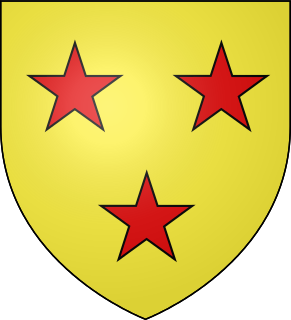
Dornoch is a town, seaside resort, parish and former royal burgh in the county of Sutherland in the Highlands of Scotland. It lies on the north shore of the Dornoch Firth, near to where it opens into the Moray Firth to the east.

Earl of Sutherland is a title in the Peerage of Scotland. It was created circa 1230 for William de Moravia and is the premier earldom in the Peerage of Scotland. The earl or countess of Sutherland is also the chief of Clan Sutherland.

Dornoch Cathedral is a former cathedral and is now a Church of Scotland parish church serving the small Sutherland town of Dornoch, in the Scottish Highlands. As a congregation of the Church of Scotland, which is Presbyterian, the church is not the seat of a bishop but retains the name due to being, historically, the seat of the Bishop of Caithness. The Cathedral's churchyard is adjoined by Dornoch Castle, the somewhat reconstructed remains of the medieval palace of the Bishops of Caithness.

Clan Sutherland is a Highland Scottish clan whose traditional territory is the shire of Sutherland in the far north of Scotland. The chief of the clan was also the powerful Earl of Sutherland, however in the early 16th century this title passed through marriage to a younger son of the chief of Clan Gordon. The current chief is Alistair Sutherland who holds the title Earl of Sutherland.

Duffus Castle, near Elgin, Moray, Scotland, was a motte-and-bailey castle and was in use from c.1140 to 1705. During its occupation it underwent many alterations. The most fundamental was the destruction of the original wooden structure and its replacement with one of stone. At the time of its establishment, it was one of the most secure fortifications in Scotland. At the death of the 2nd Lord Duffus in 1705, the castle had become totally unsuitable as a dwelling and so was abandoned.

Skelbo Castle is a ruined 14th century keep, located near Dornoch, Sutherland, Scotland. The remaining wall is best preserved at the northern side of the castle. The remains are protected as a scheduled monument.
Pulrossie is a farm in Sutherland, in the Highland council area of Scotland. It is situated on the northern shore of the Kyle of Sutherland, 8 km west of Dornoch. Skibo Castle is 1.5 km to the north-east, while Meikle Ferry is 1.5 km south-east.

Borve Castle in Sutherland, Scottish Highlands is now a ruin. Formerly called the House of Burro. It was built in Kirtomy Bay near the hamlet of Farr. It is also known as Farr Castle.

John Sutherland, was the 7th Earl of Sutherland and chief of the Clan Sutherland, a Scottish clan of the Scottish Highlands.

John Sutherland, was the 8th Earl of Sutherland and chief of the Clan Sutherland, a Scottish clan of the Scottish Highlands.
The Murrays of Aberscross were a minor noble Scottish family who were seated at Aberscross Castle, in the county of Sutherland, Scotland. The Murrays in Sutherland are recorded specifically as a clan in two Acts of the Scottish Parliament of the 16th century.

The Battle of Torran-Roy was a Scottish clan battle that took place in the year 1570 in the county of Sutherland, Scotland. It was fought between the forces of Alexander Gordon, 12th Earl of Sutherland and the forces of George Sinclair, 4th Earl of Caithness. The Earl of Sutherland's force consisted primarily of the Murrays of Aberscross who despite their name were not part of the Clan Murray in Atholl, but who were a sept of the Clan Sutherland, and who as the principal vassals of the Earl of Sutherland, were charged with the defense of the shire. The Earl of Caithness's forces consisted primarily of followers of Alexander Sutherland, 8th of Duffus who was a descendant of the old Sutherland Earls of Sutherland who had been ousted and replaced by the Gordons as earls in the early 16th-century.

Richard de Moravia or Richard de Moray of Culbin or of Cubyn, was a Scottish nobleman famed for his victory over the Vikings at the Battle of Embo which took place in Sutherland, Scotland in 1245.

Petty Castle, near Petty, Highland, Scotland, was a motte-and-bailey castle. The castle was the caput of the barony of Petty. Petty was held by the de Moravia family in the 13th century. The motte and bailey castle appears to have been replaced by the House of Petty by the 16th century, as the motte and bailey was known as Halhill, after being raided by the Mackintosh family, after the lands were given to John Ogilvy of Strathearn.

Drumsagard Castle, near Cambuslang, South Lanarkshire, Scotland, was a motte and bailey castle which was then built of stone. The castle was the caput of the barony of Drumsagard. Drumsagard was held in the 13th century by the Oliphant family, before it passed by marriage to the de Moravia family. It passed to the Douglas family in 1370 by the marriage of Archibald Douglas, Earl of Douglas to Johanna, daughter of Thomas Moray of Bothwell. The Hamilton family were granted the lands in 1452.

The Battle of Embo was a battle that took place at Embo in Sutherland, Scotland in 1245. It was fought by Scottish forces against Viking invaders who were defeated.

William de Moravia was a Scottish nobleman, Earl of Sutherland and chief of the Clan Sutherland, a Scottish clan of the Scottish Highlands.

William de Moravia, was a Scottish nobleman, 2nd Earl of Sutherland and chief of the Clan Sutherland, a Scottish clan of the Scottish Highlands.

William Sutherland, 7th of Duffus was a Scottish member of the nobility and a cadet of the Clan Sutherland.

Alexander Sutherland, 8th of Duffus was a member of the Scottish nobility and a cadet of the Clan Sutherland.
















